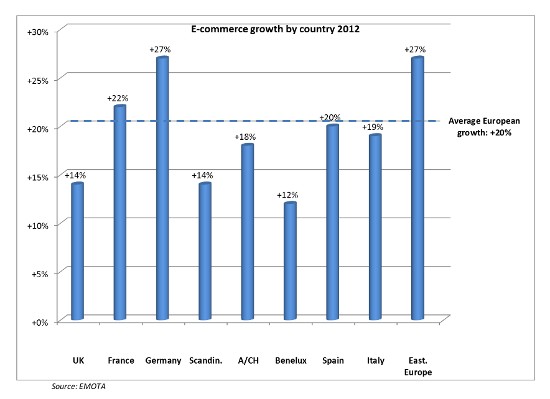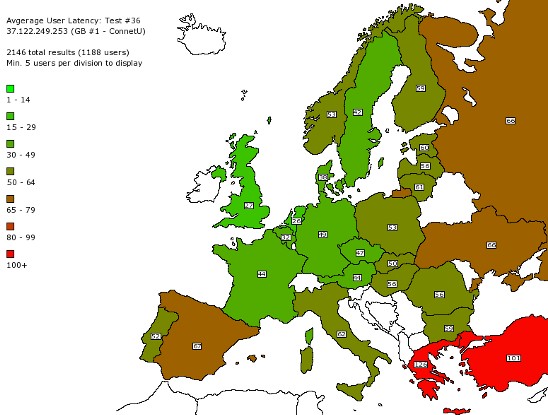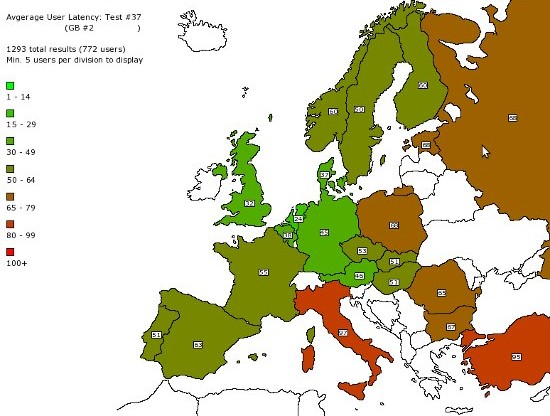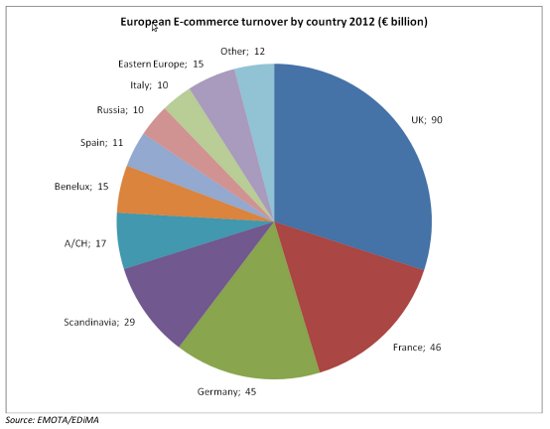IP Transit Peering for London Colocation
Thu, 31 Jan 2013
networking
Following ConnetU’s recent listing at peering exchanges in both London and Paris, we decided a blog was in order so that we could explain to our present and future customers how these changes will enhance their services.
A recent annual study by the European Multi-Channel and Online Trade Association (EMOTA) has found that the UK remains the clear EU leader in terms of online trade. However, others such as Germany and France, who together make up a third of the overall online market in Europe, are catching up fast. The chart below shows growth for 2012:

London based colocation clients and other data centre users in the capital are increasingly aware of the need for quality connectivity to the continent and need to be certain that their ISPs are providing the service they need to successfully achieve their European presence. With this in mind, let’s take a closer look at some of the technologies involved in providing quality connectivity between London and Europe.
The mesh of networks that makes up the Internet offers up a complex fabric of IPv4 destinations reached through TCP/IP determined routes. There are over 450,000 routes presently in use on the public Internet and determining which of them to use is far from a straightforward exercise.
Engineers maintaining ISP networks have control over which other networks they can be directly connected to, or not, as the case may be. They therefore have some freedom to dictate which route Internet traffic will take on leaving their network (for a more details on the technologies used to build and manage the Internet, see this earlier blog).
Engineers maintaining ISP networks have control over which other networks they can be directly connected to
A connection between networks is known as peering and can occur in a number of ways. A common form of peering is for smaller ISPs to connect directly to large international carriers such as NTT Global or Level 3. The benefits of these connections are straight forward: Large carriers can provide all routes to all IP destinations on the Internet. Connectivity is guaranteed so long as the carrier is online.
ISPs, such as ConnetU, will usually take this form of direct peering from more than one of these international carriers, known as Tier 1s, so that reachability is always available should a single carrier go down. However, there are certain drawbacks: Tier 1 carriers are expensive and costs must inevitably be passed on. Furthermore, carriers such as these operate large networks. Packets entering may have to traverse many hops to reach their egress point adding latency and reducing reliability.
These performance and financial drawbacks are the price paid for guaranteed delivery of your packets globally. However, there is a popular peering option that allows network operators to circumvent large Tier 1s. Internet Exchanges fulfil this function by providing a platform for network operators move reciprocal traffic between each other.
Internet Exchanges such as LINX and France-IX allows network operators to circumvent large Tier 1 carriers
By connecting to an exchange platform core, or directly to other network operators over the exchange fabric, individual networks avoid the potentially excessive hop-count often experienced routing through a Tier 1. For this reason, exchange peering often provides improved reliability and lower latency, important for services such as gaming and and trading platforms.
Judicious and informed management of a mix of route providers, Tier 1s and Internet exchanges, is essential in order to provide optimal service. The benefits are tangible to the end user as this recent side-by-side comparison of data centre ISPs make clears. Here, the optimised ConnetU network is revealed by the prevalence of green areas over orange/red areas, where green indicates lower latency:


The ConnetU map (top) looks even more relevant when we see exactly which countries in Europe dictate the largest share of the online marketplace, as can be seen by this pie chart:

Furthermore, peering at multiple Internet exchanges means that an ISP routing platform has more than one connection to a counterpart exchange listed ISP, allowing for greater route sharing.
The benefits of European peering for London colocation clients are the same as those for cloud or dedicated server clients. Bandwidth provided with these services will bring with it improved routes, which in turn can offer increased performance and reliability to the delivery of web services in Europe.
Come join us on: